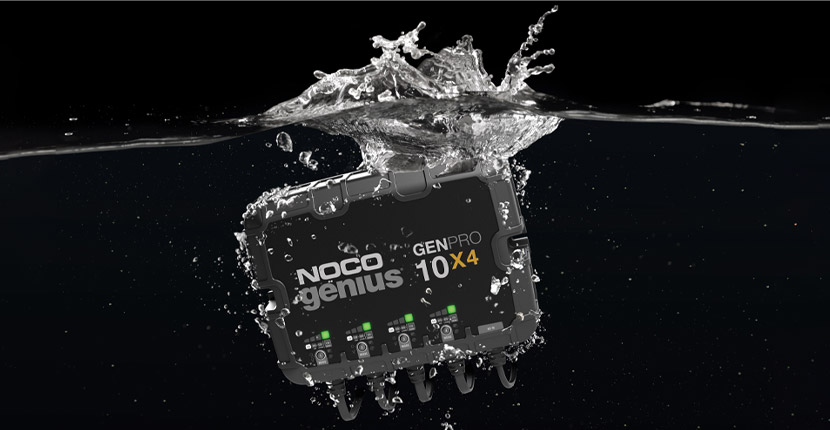How Does an Onboard Battery Charger Work on a Boat?
- by Bryan Veldboom - updated on 6/21/2022

If you're someone who spends a lot of time on the water, an onboard battery charger is a must-have for your boat. An onboard battery charger is made of up to four separate battery chargers (referred to as "banks") that are housed together in a single casing that can be mounted on your boat. This allows you to charge multiple batteries simultaneously, instead of having to charge them one at a time. Keep reading for valuable tips on how to find the right onboard charger for your boat.
What are Some Onboard Battery Charger Suggestions?
Batteries Plus has a number of onboard chargers available. Here are a few of our top suggestions:
- NOCO GENPRO 10x2 2-Bank, 20-Amp On-Board Battery Charger & Maintainer
- NOCO 3-Bank 15-Amp Onboard Battery Charger
- NOCO GENPRO 4-Bank 40-Amp Onboard Battery Charger
Does My Boat Motor Charge My Battery?
Boats typically have two different types of batteries on board; starting batteries to turn over the engine and deep cycle batteries that power additional accessories like trolling motors, fish finders and live well pumps. Most modern outboard motors that have an electric start will have an alternator which will charge your starting battery once the motor is running. That takes care of the starting battery, however, the alternator will not charge your deep cycle batteries.
In order to maintain your deep cycle batteries, you need a separate charger just for them. Having an onboard charger saves you the hassle of having to disconnect your batteries at the end of the day in order to charge them. With an onboard charger, charging your deep cycle batteries is as simple as plugging in the charger once you reach land. Plus, if your outboard motor doesn't have an alternator, you can use your onboard charger for your starting battery too.
Should I Leave My Onboard Charger Plugged In?
When charging any battery, you need to be sure that you don't overcharge it. Overcharging a battery can cause irreparable damage, drastically shortening its lifespan. Basic battery chargers need to be monitored while charging to ensure that the battery doesn't become overcharged.
Most onboard chargers, however, will come equipped with some sort of protection against overcharging, typically a float or maintenance mode. Once your battery reaches its ideal state of charge, the onboard charger will go into float mode and switch itself off automatically. Once the battery drops below its optimal state of charge, the charger will switch itself back on and begin charging the battery once again. If your onboard charger has a float or maintenance stage, you can keep it plugged in indefinitely without fear of overcharging your battery.
What Onboard Battery Charger Do I Need?
When selecting an onboard charger, make sure that you do a little research first. Since you're going to be installing it on a boat, the charger you select should be fully waterproof, resistant to corrosion and able to be mounted in damp or wet locations. As with any battery charger, you also need to make sure that it's compatible with the chemistry and voltage of the batteries onboard your boat. For instance, if you have a flooded 12 volt lead acid starting battery and a 12 volt AGM deep cycle battery, you will need a charger with separate banks for each of those battery types.
How Do I Install an Onboard Charger?
Most onboard chargers will come with instructions on how to mount them in your boat. The process is fairly straightforward and can typically be completed in a matter of hours. If you aren't particularly technical though, you can have it installed professionally.
A few things to keep in mind. When mounting the charger, be sure to keep some space between the charger and the batteries, but position it close enough so that the cables can reach the battery terminals. You also want to make sure that the plug can be easily connected to an extension cord when it's time to charge.
How Long Does It Take for a Marine Battery to Charge?
In order to determine a battery's charging speed, you need to know two things: the amp hour rating of your battery and the amperage of the battery charger. Once you have this information you can determine the charging time by dividing the battery's amp hour rating by the amperage of your charger. For example, a 75Ah battery using a 7.5 amp charger will take roughly 10 hours to fully charge.
Shop Batteries Plus for Your Boating Essentials
Batteries Plus features plenty of additional boat battery chargers both online and at your nearest location. We also carry starting, deep cycle and dual purpose marine batteries, including our exclusive X2Power lithium batteries, which last 10 times longer than traditional lead acid batteries. If you're new to the world of boating, you can find plenty of useful information in our Marine & Boat Battery Buying Guide or in our blog article entitled "Why Do Boats Have 2 Batteries?"